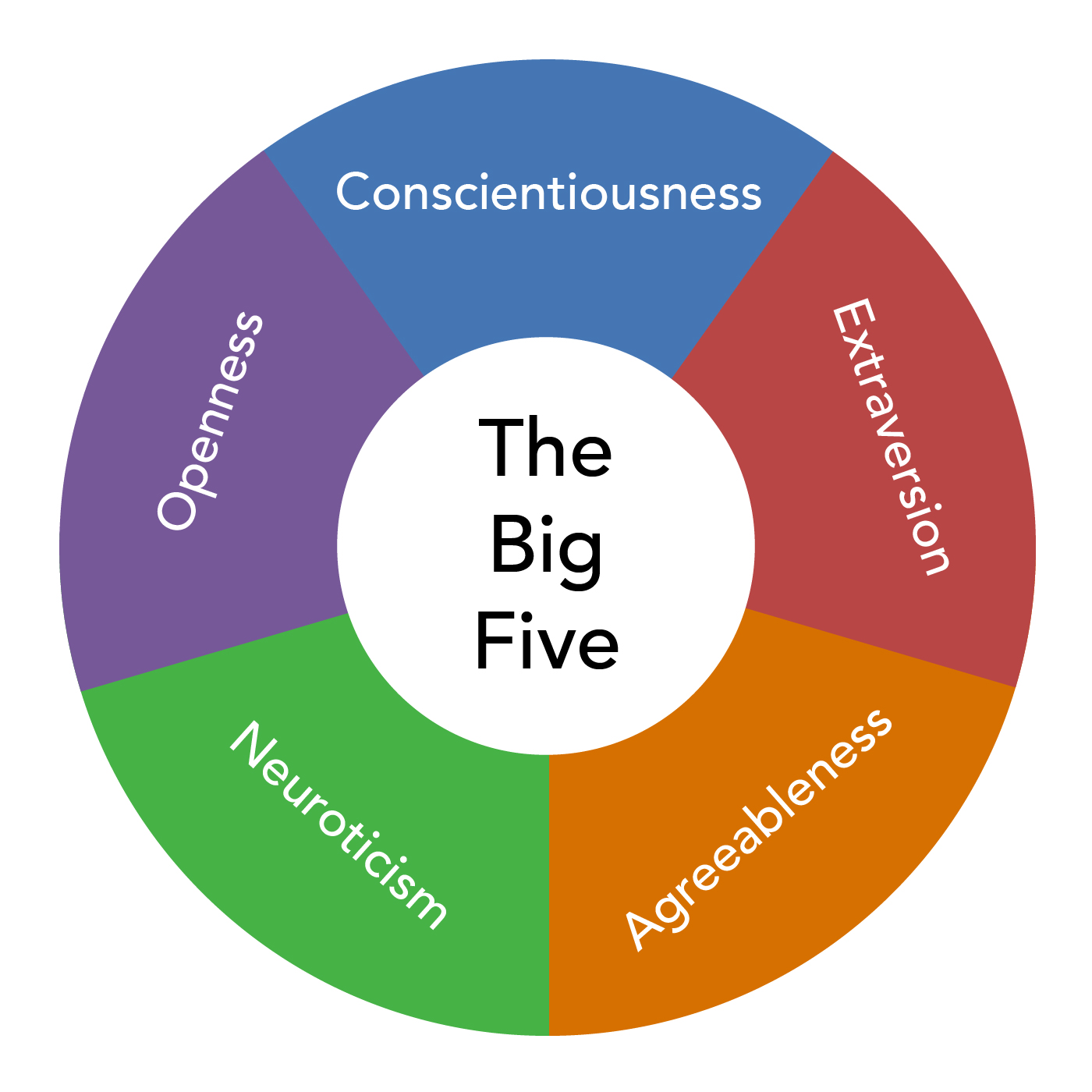4.5: Personality Traits
- Page ID
- 48627
Learning Objectives
- Examine personality traits
Recognizing your personality traits is the first step in successfully achieving your goals. Being able to capitalize on your strengths and also understanding how to strengthen your weaknesses is the cornerstone of success. When we use our personality to make decisions best suited for ourselves, we are more likely to find long-lasting happiness and satisfaction. Similarly, understanding the personalities of others will help us to form stronger relationships.
I n some ways, finding someone with differing personality traits can be beneficial. Relationships involving individuals with opposite personalities can challenge each person to view situations from a different perspective. In the workplace, differing personality traits are important to creating a diverse workplace where creativity and varying ideas can thrive. At the same time, it is also important to surround yourself with people who have similar core beliefs, values, and goals. If you are generally a positive person but choose to surround yourself with negative people, you will most likely become more pessimistic. This type of toxic personality trait can be detrimental to the workplace. Hiring employees while taking their personality into consideration (through behavioral based interview questions, personality tests, etc.) can help foster an inclusive and positive work environment.
n some ways, finding someone with differing personality traits can be beneficial. Relationships involving individuals with opposite personalities can challenge each person to view situations from a different perspective. In the workplace, differing personality traits are important to creating a diverse workplace where creativity and varying ideas can thrive. At the same time, it is also important to surround yourself with people who have similar core beliefs, values, and goals. If you are generally a positive person but choose to surround yourself with negative people, you will most likely become more pessimistic. This type of toxic personality trait can be detrimental to the workplace. Hiring employees while taking their personality into consideration (through behavioral based interview questions, personality tests, etc.) can help foster an inclusive and positive work environment.
Before we dive into the varying types of personalities and how personality traits can be categorized we first need to address the difference between personality and character. Though the two are often used interchangeably, they are indeed two different topics. Personality is fairly easy to identify early in a relationship. Even when just first meeting someone, it is easy to tell if that person is outgoing, talkative, funny, or energetic. It is also easy to determine if someone is boring, negative, or shy. On the other hand, character traits such as loyalty, honesty, kindliness, etc. are harder to identify immediately upon meeting someone. Character traits require experience with an individual to fully understand and interpret their choices and actions. While having a strong character is extremely important for any strong relationship, for the purpose of this section, we will focus primarily on personality.
Thousands of personality traits have been identified over the years. It would be nearly impossible to find an effective way to identify each and every one of an individual’s personality traits. To help streamline the process, multiple types of personality tests are available to help individuals recognize their strengths, preferences, communication style, among many other important characteristics. Let’s look into some of the most popular personality tests used today.
Myers-Briggs Type Indicator
First, let’s examine the Myers-Briggs Type Indicator (MBTI). This test was created by Isabel Myers and her mother, Katherine Briggs. They made the first assessment in the 1940s based on their familiarity with Carl Jung’s theory on personality types. Myers and Briggs did not intend to point out people’s flaws but instead aimed to help people better understand themselves so they could live a happier life. They used four different scales in their assessment:
- What energizes you and gets you excited?
- Extraversion (E): Are you a person who draws energy from the outside world of people, things, activities or interaction most of the time? (Keywords: external, outside thrust, talks out, thinks of many things, involved with people/things, interaction, action, do-think-do)
- Introversion (I): Are you a person who draws energy from the internal world of ideas, emotions or impressions most of the time? (Keywords: internal, inside thrust, hold back on comments, thinks deeply of few things, involved with own thought, work alone, reserve, think-do-think)
- Where do you put most of your attention?
- Sensing (S): Do you prefer to take in information through the five senses, noticing what is here and now most of the time? (Keywords: The five senses, what is real, practical, present orientation, facts, using established skills, utility, step-by-step)
- Intuition (N): Do you prefer to take in information through a “sixth sense,” noticing what might be most of the time? (Keywords: sixth sense, hunches, what could be, theoretical, future possibilities, insight, earning new skills, novelty, leap around)
- What do you value most when making a decision or judgment?
- Thinking (T): Do you prefer organizing and structuring information and deciding in a logical, objective way most of the time? (Keywords: head, logical system, objective, justice, critique, principles, reason, firm but fair)
- Feeling (F): Do you prefer organizing and structuring information to decide in a personal, value-oriented way most of the time? (Keywords: heart, value system, subjective, mercy, compliment, harmony, empathy, compassionate)
- What do you show outwardly most of the time?
- Judging (J): Do you prefer living a planned and organized life and are strong on decision making most of the time? (Keywords: plan oriented, regulate, control situation, settled, run one’s life, set goals, decisive, organized)
- Perceiving (P): Do you prefer for living a spontaneous and flexible life and are strong on information gathering most of the time? (Keywords: spontaneous oriented, flow along, adapt to situation, tentative, let life happen, gather information, open, flexible)
Based on how they answered questions in each category, participants receive a four letter code using one letter from each of the four categories listed above (e.g., ISTJ, ENFP). These four letter codes categorize individuals into 16 different personality types.
Try It
If you are interested. you can take the Myers-Briggs Type Indicator test online.
The Big Five
 Another popular way to assess a person’s personality is the The Big Five. The Big Five is a psychology based assessment that focuses on five wide-ranging categories that describe personality. The acronym used for The Big Five is OCEAN and include openness, conscientiousness, extraversion, agreeableness, and neuroticism.
Another popular way to assess a person’s personality is the The Big Five. The Big Five is a psychology based assessment that focuses on five wide-ranging categories that describe personality. The acronym used for The Big Five is OCEAN and include openness, conscientiousness, extraversion, agreeableness, and neuroticism.
Openness
People high in openness are more likely to be creative thinkers and enjoy taking on new activities and challenges. People low in this trait tend to be less imaginative and may not do well with change.
Conscientiousness
People high in conscientiousness are good at planning ahead, organizing details, and meeting deadlines. They are also mindful of others and understand how their decisions and actions can influence those around them. People who are low in conscientiousness procrastinate on or fail to complete tasks. They also tend to be shy away from schedules and live unorganized lives.
Extraversion
People high in extraversion enjoy meeting new people and inserting themselves into gatherings and conversations. They tend to make friends easily and have a large group of friends. People low in extraversion, also known as introverts, prefer seclusion over company. They also try to avoid small talk and being at the center of attention.
Agreeableness
People high in agreeableness show a genuine concern for others. They are known for helping others in need and feeling empathy for the struggles of others. On the other hand, people low in agreeableness tend to act rude and inconsiderate towards others or even use manipulation to put their own needs above anyone else.
Neuroticism
Someone high in neuroticism tends to be very moody, stressed, and anxious. They may get stressed and upset easily. People low in neuroticism tend to be emotionally stable and do not allow stressors to effect their mood.
Practice Question
Each personality test we discussed are used today to help companies better understand their employees or employee candidates. It is important to remember that there are thousands of different personality traits. Each individual has their own unique set and combination of personality traits. While each of the personality tests we discussed in this module are effective in their own right, there is no exact science to identifying each and every personality trait present in an individual. In addition, many personality tests are based upon an individual’s self-assessment and results may differ from day to day. Personality tests may help to confirm things you already believed to be true or they may open your eyes to a side of yourself you didn’t realize existed. Let’s move onto the next section to examine how an individual’s personality can help to predict their choices and behavior.
Try It
Check out these pages to learn more about personality:
- “Personality vs. Character,” Psychology Today
- “Myers-Briggs Type Indicator: The 16 Personality Types,” Verywell Mind
- “What Are the Big 5 Personality Traits?” Verywell Mind
Contributors and Attributions
- Personality Traits. Authored by: Freedom Learning Group. Provided by: Lumen Learning. License: CC BY: Attribution
- Image: The Big Five. Provided by: Lumen Learning. License: CC BY: Attribution
- Modification of Using the Myers-Briggs personality test for teams. Authored by: Ron McFarland. Provided by: OpenSource.com. Located at: https://opensource.com/open-organization/16/7/personality-test-for-teams. License: CC BY-SA: Attribution-ShareAlike
- Untitled. Authored by: Omar Lopez. Provided by: Unsplash. Located at: https://unsplash.com/photos/rwF_pJRWhAI. License: CC0: No Rights Reserved. License Terms: Unsplash License

